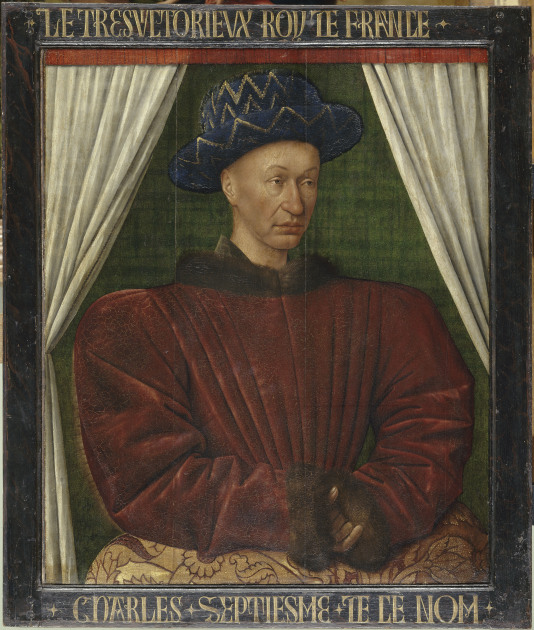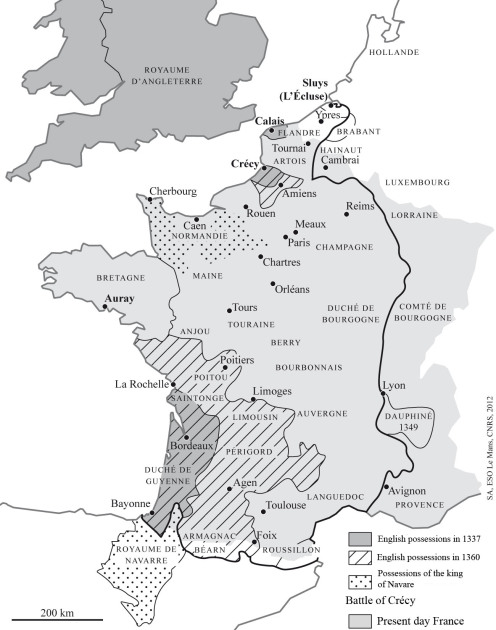The reinforcement of royal institutions
Church-backed monarchs
The French and British monarchies obtained by « divine right »
. The king had been chosen by God to run the government of the kingdom. In France his legitimacy was confirmed by his coronation in Rheims Cathedral, and in England, in Westminster Abbey. The highest church authority thereby reinforced the sovereign's authority who swore in return to defend the Church. Throughout the period under review this alliance held good. Even at difficult times such as succession crises, the clergy would, as a whole, support and extol the monarch's authority. Created in the 13th century, the universities[1] were church institutions which trained, notably in Paris and Oxford, the kingdom's administrators. Furthermore, the monarch had control over the nomination of a number of bishops and abbots known as « royal »
. The seigneuries ruled by such prelates would, as a result, mostly back the policies of the king who may further claim the revenues from vacant Episcopal sees in application of Jus regalia[2].
By the mid 14th century the royal government was able to curtail ecclesiastical courts' independence and to tax church property by means of Decimes[3] raised under pretence of fundraising for further crusades. The English parliament[4] took steps to counter papal opposition thus divesting the Papacy of some of its authority. The pontifical monarchy's bureaucratic innovations were incidentally imitated elsewhere. The crisis inflicted on the Papacy by the 1378 Western Schism[5] and the growing approval of conciliarism[6] furthered the autonomization of the « national »
churches. The monarch would pose as the defender of his kingdom's clergy before a weakened papacy. In France, in 1438, Charles VII[7] decreed a Pragmatic Sanction before his assembled clergy in Bourges. Its decisions placed the church of France under the king's authority, notably with regards to the collation[8] of numerous benefits[9]. Pontifical taxes on the French clergy were abolished and the supremacy of royal justice over ecclesiastical jurisdictions confirmed. Royal Gallicanism[10] asserted itself even in recommendations regarding liturgy and the discipline to be observed by clerics.
 Informations[11]
Informations[11]The specialisation of central monarchic institutions
In the 13th century the daily management of royal domestic needs, the royal household or Hôtel du roi[12] gradually became separate from the monarchy's administrative departments. In France high ranking and ordinary officers of the Crown assisted the king: the Chancellor of France, keeper of the seals[13] and his notaries or secretaries: the Lord High Constable[14] and his marshals, the chamberlains[15] ... In England the tasks of the Royal Household were shared out between the Wardrobe[16] and the Chamber. The monarch chose as officers of the Royal Household noblemen or churchmen upon whom he was keen to bestow a reward in the shape of increased influence in their field of expertise. Most of them would assist or actually represent the monarch in the administration of the kingdom via its diverse councils. In both countries the Royal Council became the organ drawn from the Court within which the most important decisions were taken. The king himself chose the members of his council, wherein he introduced lay or church men whom he trusted and whose role was paramount. In the king's absence, the Lord Chancellor chaired the debates. Any question may be raised at the council as it pleased the king. The monarch could call his council to sit as a law court, withholding such affairs, say the trial of great lords, as could be dealt with within a Court of Peers. In France the King's Council also acted as a court of cassation with power to rescind the Parliament[17]'s decisions.
From the beginning of the 14th century, royal justice asserted itself as superior to all other jurisdiction, be it seigneurial, ecclesiastical or municipal. Appeals against the judgements of lower courts, royal or otherwise, were put to a high court of justice. In France, this fell to the Parliament of Paris based in the royal Palace of the Île de la Cité and at times presided over by the Chancellor. It was made up with lay and clergy councillors, the latter competent to handle business coming under canon law[18]. In England this fell to the Common Bench or Court of Common Pleas with possibility of appeal to the King's Bench the judges of which, the justices in eyre, convened at the Palace of Westminster. These juridical structures gradually came together as royal rulings were decreed. In 1345, king Philip VII[19] granted Parliament its final statutes. As from 1443 and the official advent of the Parliament of Toulouse, the Parliament of Paris doubled up with several provincial parliaments which helped extending the presence of royal authority in matters of justice throughout the land.

 Informations[20]
Informations[20]With the onset of the Hundred Years War, the monarchy's financial needs kept increasing. In England, the Exchequer[21] had been since the 12th century the central organ for all royal financial affairs. The lower exchequer or Exchequer of Receipts controlled revenues. The upper exchequer or Exchequer of Accounts produced financial statements which were the forerunners of provisional budgets. It audited accounts and judged prevaricating officers. In France the Finances ordinaires[22] were kept separate from the Finances extraordinaires[23]. From 1370-1390, the Chambre du Trésor (treasury) was responsible for the former. The Court of Aids, set up between 1356 and 1390, pooled the monies raised by direct and indirect taxation. The Court of Accounts[24], reorganised by the 1320 Ordinance of Vivier en Brie, had a broader role in terms of jurisdictional control and policy making.
The development of a provincial administration
England had a long-standing territorial administrative machinery that did not differentiate between the royal demesne and the great fiefdoms. The kingdom was divided in shires[25], which were subdivided into hundreds. Unwaged local officers were chosen among the local gentry. At shire level, the sheriff[26] carried out the shire courts' sentences as well as royal orders, namely tax collection and the levy of troops. The coroner, presiding over a shire court, investigated criminal affairs. Escheators had the control of all the king's estates. However, the administration of justice in the provinces was complemented by regular tours conducted by London magistrates from the King's Bench. In 1360, royal justices of the peace – still known as “keepers of the king's peace” – were appointed in all shires.
In France, the king had, since the 13th century been represented by baillis or sénéchals[27], both words addressing the same role. Baillages were to be found mostly in the north whilst sénéchaussées were operant in the South and West. Their waged local officers drawn from the lower ranks of the aristocracy and trained in the Law, dispensed justice in the name of the king, collected domanial revenues, took charge of law and order, levied troops for the ost royal[28] and supervised the desmene's local agents, the provosts[29]. Their constituency extended to the great fiefdoms, be they ecclesiastical. Although these did not stricto sensu belong to the royal desmene, they intervened in their affairs with increasing frequency, regardless of the strong opposition they met. In 1350 during John II[30]'s reign, in view of the breadth of their activity, the central power assigned to them lieutenants de justice qualified in law to act as judges; they presided over the baillages and sénéchaussées' court sessions. They also received the assistance of domanial financial officers and ordinary tax collectors.
 Informations[31]
Informations[31]Starting in the middle of the 14th century, the French monarchy's war-driven financial requirements lead to its introducing throughout the kingdom an extra grid of fiscal administration charged with assessing and collecting an extraordinary direct taxation to be raised per parish[32]. These levies were voted by representative assemblies. Originally, as did the Estates of langue d'Oil of 1355 for their northern constituencies, these assemblies assumed the right to appoint the men charged with the task of assessing and collecting the levies. Accordingly, they were known as the élus (the elected) and their administrative wards as élections[33], with boundaries matching those of the dioceses[34]. As early as the 1360s, the royal power had regained control over the élections and was appointing in person the élus, set under the control of généraux des finances[35].
The gradual establishment of a standing army
At the beginning of the Hundred Years War, the king of England's army enjoyed one advantage over that of his opponent. Its contingents were organised in specialised units. During the early battles at Sluys (1340), Crécy (1346) and Poitiers (1356), the Welsh archers made the demonstration of the superiority of such dispositions. For their part, the French called upon cohorts of knights performing their vassalic duties and arrayed in « battles[36] »
on the one hand, and on the other on mercenaries, especially in specific sectors, the navy and units of crossbowmen. This combination lacked cohesion. English effectiveness was such that king of France Charles V[37], chose to avoid frontal engagements. He made up lost ground by rebuilding the kingdom's defensive organisation. In 1367, he compelled the towns to refurbish their walls and train local groups of fighters. In 1373, he opted for a wholly contract army whose men got allotted to companies[38] lead by captains directly responsible for their men: recruiting, paying and commanding those soldiers.
In 1415, the French rout at Agincourt enabled Henry V[39] to gain a foothold in Normandy and in the Paris region. Charles VII reversed the balance of power in the years around 1430. He expelled his English foe from Normandy and Guyenne between 1450 an 1453 thanks to his earlier move towards a standing army. In 1445, the ordinance of Louppy-le-Châtelet provided for the breaking down of the army into 15 so called « compagnies d'ordonnance »
. Each company engaged on a permanent basis, was comprised of 100 lances built around six knights. In 1448 the Ordinance of Le Mans made the creation of a reserve of francs-archers compulsory. The king further encouraged the creation of a field artillery corps.









